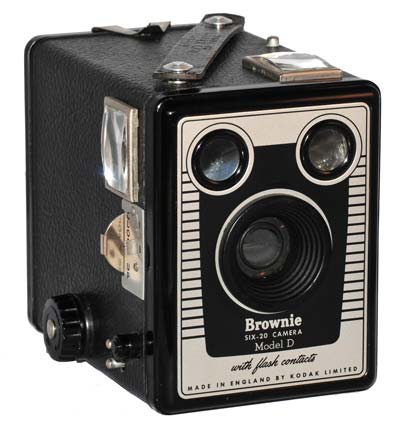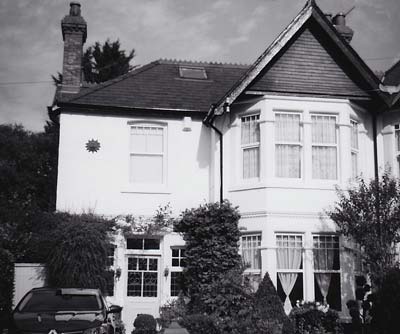Kodak Brownie Six-20 Model D with Flash Contacts
Specification

| Manufacturer | : | Kodak |
|---|---|---|
| Produced | : | 1953-1957 |
| Classification | : | Medium Format |
| Body Type | : | Box |
| Construction | : | Metal |
| Film Type | : | 620 |
| Film Width | : | 62mm |
| Image Size | : | 2¼ x 3¼ in |
| No. of Images | : | 8 |
| Lens Type | : | Meniscus |
| Focus Type | : | Fixed with close-up lens |
| Focal Length | : | 100mm |
| Focus Range | : | 10ft to inf |
| Aperture Type | : | Fixed |
| Aperture | : | f/11 |
| Shutter Type | : | Rotary |
| Shutter Speeds | : | B,I(1/40 sec) |
| Size (w x h x d) | : | 85 x 104 x 118 mm |
| Weight | : | 390g |
Art Deco Credentials
![]()
Limited: Minor and insubstantial
- Produced after the main Art Deco period;
- Horizontal stripes to front panel;
- Rounded corners from the streamline era;
- Concentric circles on the winder, shutter button and strap posts;
- Chrome embellishments;
- Symmetrical face.
Description
The Kodak Brownie Six-20 Model D is a box-type camera from the 1950s. It is similar to the Model C which was without flash contacts. The facade has the horizontal stripes and the corners are rounded reminiscent of the Streamline Moderne period. Other features like the concentric circles and the chrome embellishments give a nod to the main Art Deco period. These minor design features give this camera very weak credentials in terms of Art Deco. However, it is often quoted as being Art Deco by sellers trying to boost its saleability.
The camera supports portraits by using a 'close up' lens that can be moved into position by pulling a tab on the side. Focus with the portrait lense is between 3 and 6ft.
How to Use
See Instruction Manual here. This camera takes 620 film which is still available from selected photographic outlets. Although the actual film is the same as 120 film, the spools are different. The 620 spools are slightly shorter and have a smaller diameter. Do not use 120 film in this camera because it will jam and may snap. It is possible to cut down a spool of 120 film to fit or to re-spool some 120 film onto 620 spools in a darkroom or changing bag.
Don't forget to ask for your 620 spool back when getting the film developed.
As the shutter speed is only 1/40s, it is advisable to use a tripod to get clear shake free images. However, holding it against a wall or other solid object would work as well. For quick snapshots, hold it firmly against your body.
If you don't want to bother with an exposure meter, follow the guide shown. It is based on the 'Sunny 16' rule. Film is so forgiving and will produce acceptable results even when overexposed by 2 or 3 stops or underexposed by 1 stop.
The tables assume that the sun is at least 30 degrees above the horizon - that's 10am - 5pm on a summers day in the UK.
Remember that the exposure guide in the manual may not be helpful as it is based on the use of old film with a low ISO value.
Using ISO 100 film - shutter speed 1/40s
| Weather Conditions | Shadow Detail | Aperture | Exposure |
|---|---|---|---|
 Sunny SunnySnow/Sand | Dark with sharp edges | f/11 | +3 Stops Overexposed Acceptable |
 Sunny Sunny | Distinct | f/11 | +2 Stops Overexposed Acceptable |
 Slight Overcast Slight Overcast | Soft around edges | f/11 | +1 Stop Overexposed Acceptable |
 Overcast Overcast | Barely visible | f/11 | Good |
 Heavy Overcast Heavy Overcast | None | f/11 | -1 Stop Underexposed Acceptable |
 Open Shade Open Shade/Sunset | None | f/11 | -2 Stops Underexposed Not Acceptable |
Photographs taken with this Camera
Cropped images using re-spooled Fuji Neopan Acros 120 ISO 100 on to 620 spools

